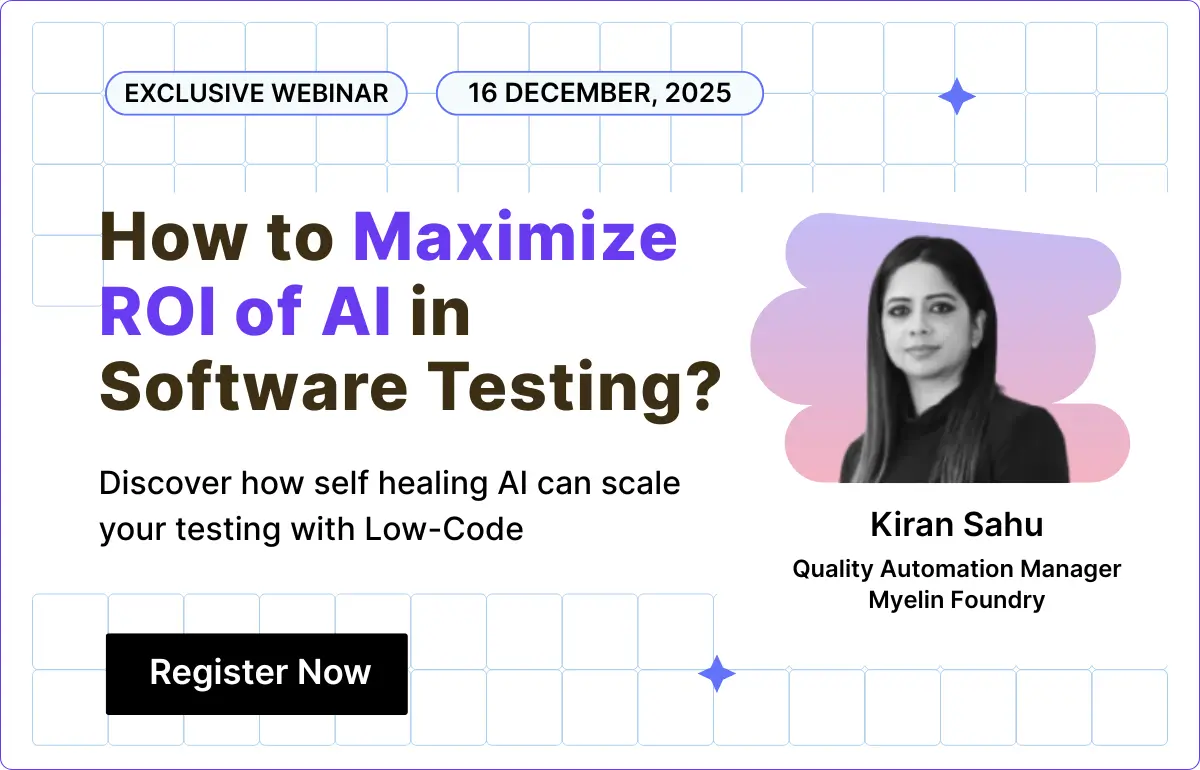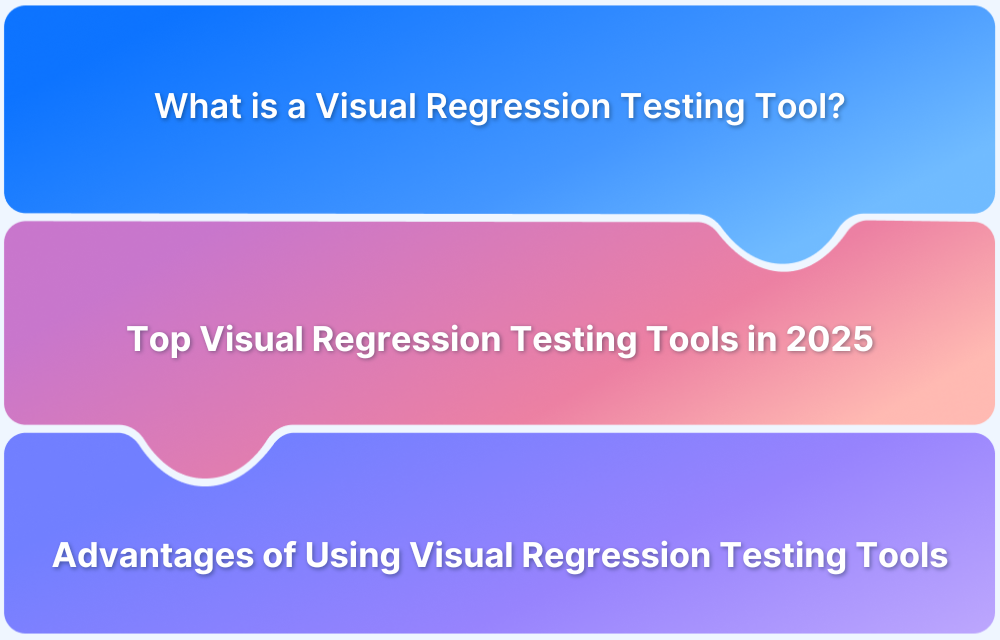Applitools Eyes is widely recognized for pioneering Visual AI technology, offering powerful, intelligent visual testing across web, mobile, and even PDFs.
However, for many teams, especially those scaling quickly or operating under strict budgets, Applitools’ proprietary model and sales-based pricing can become a major barrier, often perceived as costly and restrictive.
Overview
Top 10 Applitools Alternatives for Visual Testing:
- BrowserStack Percy: AI-powered visual testing with broad real device cloud support.
- Testsigma: No-code AI-driven test automation covering visual, functional, and API tests.
- Functionize: No-code AI-based visual and functional automation with natural language test creation.
- Testim: AI-enhanced test platform combining visual checkpoints with functional test stability.
- Mabl: No-code AI visual and functional testing with real-time analytics and CI/CD integration.
- TestGrid: Scriptless AI visual validation with instant defect reporting on real devices.
- Katalon Studio: AI-powered visual testing integrated into a broader automated testing suite.
- TestComplete: Mature platform with AI-driven UI and API test automation including visuals.
- Ranorex: Comprehensive UI automation with advanced image-based visual validation features.
- Eggplant Functional: AI-driven image and text recognition testing for broad platform support.
The article explores top-tier Applitools alternatives for visual testing that balance AI-driven quality with cost-efficiency, flexibility, and streamlined developer workflows.
What is Applitools Visual Testing?
Applitools Eyes is an intelligent visual testing and monitoring platform that uses proprietary Visual AI to ensure the user interface (UI) appears and functions correctly across multiple environments.
It moves beyond simple pixel-by-pixel comparison to replicate the human eye, intelligently validating the application’s visual output.
Key characteristics of Applitools Eyes include:
- Visual AI Engine: Uses advanced AI and machine learning to detect visual differences and anomalies, even in complex and dynamic applications, which minimizes false positives.
- Ultrafast Grid/Execution Cloud: Executes tests against hundreds of browsers and devices in minutes for fast, scalable cross-browser validation.
- Comprehensive Coverage: Supports visual testing for web, native mobile apps, component testing, and even PDFs.
- Advanced Maintenance: Features automated test maintenance, Root Cause Analysis (RCA), and UI Version Control to simplify fixing bugs at the code level.
- Flexible Deployment: Offers Public Cloud, Dedicated Cloud, and On-Premise deployment options for high security and compliance needs.
Also Read:Snapshot Testing with Jest
Why Look for Applitools Alternatives?
Despite its powerful Visual AI, several factors drive organizations to seek alternatives to Applitools Eyes:
- High Cost Barrier: The platform can be significantly more expensive than other visual testing tools, which is a major barrier for small or budget-constrained teams.
- Non-Transparent Pricing: Advanced or enterprise pricing is often not publicly revealed, requiring negotiation with sales and complicating the initial evaluation process.
- Learning Curve and Setup: Teams new to AI-powered testing may find the platform has a steep learning curve and initial setup complexity.
- Technical Limitations with Dynamic Content: Although AI-powered, the platform may still struggle to handle extremely highly dynamic content that changes very frequently.
- Limited Customization: Teams requiring highly customized workflows or extensive modifications may find the proprietary nature of Applitools less flexible than open-source or hybrid platforms.
Must Read:Automated Visual AI Testing
Top 10 Applitools Alternatives for Visual Testing
Visual validation demands a tool that balances Visual AI with affordability and ease of integration, going beyond the high-cost barrier and complexity of Applitools.
Here are some top Applitools alternatives for Visual Testing:
1. BrowserStack Percy
Percy by BrowserStack is an AI-powered visual testing platform designed to automate visual regression testing for web applications, ensuring flawless user interfaces on every code commit.
Integrated into CI/CD pipelines, Percy detects meaningful layout shifts, styling issues, and content changes with advanced AI, significantly reducing false positives and cutting down review time for fast, confident releases.
- Effortless Visual Regression Testing: Seamlessly integrates into CI/CD pipelines with a single line of code and works with functional test suites, Storybook, and Figma for true shift-left testing.
- Automated Visual Regression: Captures screenshots on every commit, compares them side-by-side against baselines, and instantly flags visual regressions like broken layouts, style shifts, or component bugs.
- Visual AI Engine: The Visual AI Engine uses advanced algorithms and AI Agents to automatically ignore visual noise caused by dynamic banners, animations, anti-aliasing, and other unstable elements. It focuses only on meaningful changes that affect the user experience. Features like “Intelli ignore” and OCR help differentiate important visual shifts from minor pixel-level differences, greatly reducing false positive alerts.
- Visual Review Agent: Highlights impactful changes with bounding boxes, offers human-readable summaries, and accelerates review workflows by up to 3x.
- No-Code Visual Monitoring: Visual Scanner allows rapid no-install setup to scan and monitor thousands of URLs across 3500+ browsers/devices, trigger scans on-demand or by schedule, ignore dynamic content regions as needed, and compare staging/production or other environments instantly.
- Flexible and Comprehensive Monitoring: Schedule scans hourly, daily, weekly, or monthly, analyze historical results, and compare any environment. Supports local testing, authenticated pages, and proactive bug detection before public release.
- Broad Integrations: Supports all major frameworks and CI tools, and offers SDKs for quick onboarding and frictionless scalability.
App Percy is BrowserStack’s AI-powered visual testing platform for native mobile apps on iOS and Android. It runs tests on a cloud of real devices to ensure pixel-perfect UI consistency, while AI-driven intelligent handling of dynamic elements helps reduce flaky tests and false positives.
With easy plug-and-play integration requiring just one line of code, App Percy supports popular frameworks like Appium, WebdriverIO, Java, and Python. Its highly scalable parallel test execution accelerates build times by 10x, while a unified dashboard offers logs, screenshots, video recordings, and compliance with key data privacy standards.
Pricing
- Free Plan: Available with up to 5,000 screenshots per month, ideal for getting started or for small projects.
- Paid Plan: Starting at $199 for advanced features, with custom pricing available for enterprise plan.
2. Testsigma
Testsigma is a no-code AI-powered test automation platform supporting visual regression testing alongside functional, API, and cross-browser tests for web and mobile apps.
Key Features:
- One-click visual check additions with AI defect identification
- Supports 3000+ browsers and devices for cross-platform testing
- Self-healing tests adapt to UI changes automatically
- Plain English and GenAI-based test creation
Pros:
- Easy for non-technical users with no-code interface
- Comprehensive test coverage beyond visual regression
Cons:
- Paid licensing required
- Learning curve for advanced AI test configurations
Must Read:TestSigma Alternatives
3. Functionize
Functionize provides AI-driven no-code test automation including visual regression for functional and full-page visual validation.
Key Features:
- AI-powered element and full-page comparison
- No-code automation with test creation in natural language
- Integrates across CI/CD pipelines and browsers
- Visual test verifications embedded in automation scripts
Pros:
- Reduces need for coding skills
- Combines visual and functional test automation
Cons:
- Pricing not publicly available, tends to be enterprise-focused
- Limited documentation for new users
Pricing: Enterprise subscription model; contact vendor for quotes
Learn More:Functionize Alternatives
4. Testim
Testim is an AI-enabled test automation platform that integrates visual regression with functional testing across web applications.
Key Features:
- AI-powered test stability and validation
- Cross-browser and mobile device testing support
- Visual checkpointing integrated with automated tests
- Test maintenance automation to reduce flakiness
Pros:
- Strong AI support reduces test failures
- Combines functional and visual testing in one platform
Cons:
- Higher pricing for smaller teams
- Requires some learning for test customization
Pricing:Tiered subscription plans; contact sales for enterprise options
Learn More:Testim Alternatives
5. Mabl
Mabl delivers no-code AI-driven functional and visual test automation with integrated analytics and CI/CD compatibility.
Key Features:
- Automated visual regression testing with AI noise suppression
- Browser and device coverage in cloud environment
- Integration with DevOps tools including Jenkins and Bamboo
- Real-time test failure analytics and debugging
Pros:
- No-code interface enables quick test creation
- Supports both visual and functional test automation
Cons:
- Pricing is high for extended usage
- Less customizable for advanced test scenarios
Pricing: Subscription-based with custom quotes; free trial available
Read More: Mabl Alternatives
6. TestGrid
TestGrid offers scriptless AI-powered visual validation with real-device cloud access and instant defect detection dashboards.
Key Features:
- Scriptless visual test creation using AI
- Real device cloud for accurate visual feedback
- Instant reporting and defect tracking dashboard
- CI/CD pipeline integration
Pros:
- Simple setup for non-technical users
- Fast feedback with minimal manual effort
Cons:
- Limited advanced customization options
- Pricing details are enterprise-specific and not public
7. Katalon Studio
Katalon Studio is a comprehensive test automation platform that includes AI-driven visual testing as part of its web and mobile testing suite.
Key Features:
- AI-based image comparison and visual validation
- Supports parallel execution and cross-browser testing
- Keyword-driven automation with easy script management
- Integration with CI/CD and ALM tools
Pros:
- Combines functional and visual testing in one tool
- User-friendly interface with keyword-driven testing
Cons:
- Licensing cost may be high for small teams
- Limited No-Code visual testing support compared to others
Also Read:Katalon Alternatives
8. TestComplete
TestComplete by SmartBear combines functional UIs, API, and visual test automation with AI-powered capabilities for web and desktop applications.
Key Features:
- Visual testing integrated with UI and API automation
- AI-powered object recognition for test stability
- Supports multiple scripting languages including JavaScript, Python
- Detailed reporting and integrations with CI/CD pipelines
Pros:
- Mature platform with broad testing capabilities
- Strong support for desktop and web apps
Cons:
- Higher license price for visual testing features
- Setup and maintenance require technical expertise
9. Ranorex
Ranorex is a test automation platform supporting UI, API, and visual testing with AI enhancements for desktop, web, and mobile apps.
Key Features:
- Advanced image-based UI validation
- Supports cross-browser and cross-device testing
- Script and codeless test creation options
- Integration with CI/CD and test management tools
Pros:
- Flexible automation environment
- Comprehensive testing coverage across platforms
Cons:
- Pricing is on the higher side for small teams
- Visual testing capability less advanced than dedicated tools
10. Eggplant Functional
Eggplant Functional uses AI-driven image recognition to automate functional and visual testing of GUI-based applications across platforms.
Key Features:
- Image and text recognition-based visual validation
- Scriptless test creation with AI assistance
- Cross-device and OS testing support
- Integration with CI/CD and other test tools
Pros:
- Powerful AI-driven test automation
- Wide range of application support (desktop, mobile, web)
Cons:
- Higher learning curve and licensing cost
- Limited open community support
Read More: Visual Regression Testing Tools Compared
Why Choose BrowserStack Percy for Visual Testing?
BrowserStack Percy stands out as a fast, developer-friendly visual testing solution that fits seamlessly into modern CI/CD pipelines. It prioritizes simplicity, accuracy, and scalability without the complexity found in heavier enterprise platforms.
Key Percy Highlights
- Fast plug-and-play setup: One-line integration with CI/CD and popular automation frameworks to start running visual tests in minutes.
- Developer-first workflow: Works natively with Storybook, Cypress, Playwright, WebdriverIO, and more for intuitive shift-left testing.
- Smart visual difference engine: Stabilizes rendering and filters noise to highlight only meaningful UI changes, reducing review fatigue.
- Collaborative review dashboard: Comments, approvals, and visual diffs in one place for smooth reviews across engineering, design, and product.
- Real browser & device coverage: Powered by BrowserStack’s cloud to validate UI across real browsers and devices.
- Scales effortlessly: Cloud-native execution with parallel testing ensures fast feedback loops as teams and test suites grow.
Conclusion
While Applitools is highly effective with its proprietary Visual AI, its complexity and high subscription costs often pose challenges for scaling teams.
Alternatives such as BrowserStack Percy deliver equivalent AI-powered validation, high scalability, and robust cross-platform coverage with greater cost-transparency and streamlined developer experience.
Selecting a dedicated visual testing platform that perfectly balances advanced features with budget simplicity is crucial for optimizing quality assurance efforts.
Useful Resources for Visual Testing
- How to capture Lazy Loading Images for Visual Regression Testing in Cypress
- How to Perform Visual Testing for Components in Cypress
- How to run your first Visual Test with Cypress
- How Visual Diff Algorithm improves Visual Testing
- How is Visual Test Automation changing the Software Development Landscape?
- How does Visual Testing help Teams deploy faster?
- How to perform Visual Testing for React Apps
- How to Run Visual Tests with Selenium: Tutorial
- How to reduce False Positives in Visual Testing?
- How to capture Lazy Loading Images for Visual Regression Testing in Puppeteer
- How to migrate your Visual Testing Project to Percy CLI
- Why is Visual Testing Essential for Enterprises?
- Importance of Screenshot Stabilization in Visual Testing
- Strategies to Optimize Visual Testing
- Best Practices for Visual Testing
- Visual Testing Definitions You Should Know
- Visual Testing To Optimize eCommerce Conversions
- Automate Visual Tests on Browsers without Web Drivers
- Appium Visual Testing: The Essential Guide
- Top 17 Visual Testing Tools








